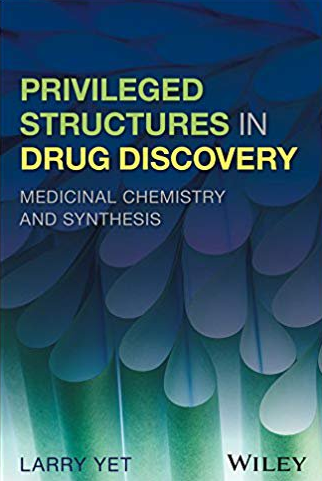Privileged Structures in Drug Discovery: Medicinal Chemistry and Synthesis by Larry Yet, ISBN-13: 978-1118145661
[PDF eBook eTextbook]
560 pages
Publisher: Wiley; 1 edition (March 27, 2018)
Language: English
ISBN-10: 1118145666
ISBN-13: 978-1118145661
A comprehensive guide to privileged structures and their application in the discovery of new drugs
The use of privileged structures is a viable strategy in the discovery of new medicines at the lead optimization stages of the drug discovery process. Privileged Structures in Drug Discovery offers a comprehensive text that reviews privileged structures from the point of view of medicinal chemistry and contains the synthetic routes to these structures. In this text, the author—a noted expert in the field—includes an historical perspective on the topic, presents a practical compendium to privileged structures, and offers an informed perspective on the future direction for the field.
The book describes the up-to-date and state-of-the-art methods of organic synthesis that describe the use of privileged structures that are of most interest. Chapters included information on benzodiazepines, 1,4-dihydropyridines, biaryls, 4-(hetero)arylpiperidines, spiropiperidines, 2-aminopyrimidines, 2-aminothiazoles, 2-(hetero)arylindoles, tetrahydroisoquinolines, 2,2-dimethylbenzopyrans, hydroxamates, and bicyclic pyridines containing ring-junction nitrogen as privileged scaffolds in medicinal chemistry. Numerous, illustrative case studies document the current use of the privileged structures in the discovery of drugs. This important volume:
– Describes the drug compounds that have successfully made it to the marketplace and the chemistry associated with them
– Offers the experience from an author who has worked in many therapeutic areas of medicinal chemistry
– Details many of the recent developments in organic chemistry that prepare target molecules
– Includes a wealth of medicinal chemistry case studies that clearly illustrate the use of privileged structures
Designed for use by industrial medicinal chemists and process chemists, academic organic and medicinal chemists, as well as chemistry students and faculty, Privileged Structures in Drug Discovery offers a current guide to organic synthesis methods to access the privileged structures of interest, and contains medicinal chemistry case studies that document their application.
Table of contents:
Content: Intro
Title Page
Copyright Page
Contents
Chapter 1 Introduction
1.1 The Original Definition of Privileged Structures
1.2 The Role of Privileged Structures in the Drug Discovery Process
1.3 The Loose Definitions of Privileged Structures
1.4 Synthesis and Biological Activities of Carbocyclic and Heterocyclic Privileged Structures
1.4.1 Synthesis and Biological Activities of Three- and Four-Membered Ring Privileged Structures
1.4.2 Synthesis and Biological Activities of Five-Membered Ring Privileged Structures 1.4.3 Synthesis and Biological Activities of Six-Membered Ring Privileged Structures1.4.4 Synthesis and Biological Activities of Bicyclic 5/5 and 6/5 Ring Privileged Structures
1.4.5 Synthesis and Biological Activities of Bicyclic 6/6 and 6/7 Ring Privileged Structures
1.4.6 Synthesis and Biological Activities of Tricyclic and Tetracyclic Ring Privileged Structures
1.5 Combinatorial Libraries of Privileged Structures
1.6 Scope of this Monograph
References
Chapter 2 Benzodiazepines
2.1 Introduction
2.2 Marketed BDZ Drugs
2.2.1 1,4-Benzodiazepine Marketed Drugs 2.2.2 1,5-Benzodiazepine Marketed Drugs2.2.3 Linearly Fused BDZ Marketed Drugs
2.2.4 Angularly Fused-1,4-Benzodiazepine Marketed Drugs
2.3 Medicinal Chemistry Case Studies
2.3.1 Cardiovascular Applications
2.3.2 Central Nervous System Applications
2.3.3 Gastrointestinal Applications
2.3.4 Infectious Diseases Applications
2.3.5 Inflammation Applications
2.3.6 Metabolic Diseases Applications
2.3.7 Oncology Applications
2.4 Synthesis of BDZs
2.4.1 Condensation of o-Phenylenediamines to 1,5-Benzodiazepines
2.4.1.1 Condensation of o-Phenylenediamines with Ketones 2.4.1.2 Condensation of o-Phenylenediamines with α,β-Unsaturated Ketones2.4.1.3 Condensation of o-Phenylenediamines with Alkynes
2.4.2 Reductive Condensation of α-Substituted Nitrobenzenes with Ketones and α,β-Unsaturated Ketones
2.4.3 Intramolecular Cyclizations to 1,4-Benzodiazepines
2.4.3.1 Intramolecular Cyclizations
Path A
2.4.3.2 Intramolecular Cyclizations
Path B
2.4.3.3 Intramolecular Cyclizations
Path C
2.4.3.4 Intramolecular Cyclizations
Path D
2.4.3.5 Intramolecular Cyclizations
Path E
2.4.3.6 Intramolecular Cyclizations
Path F 2.4.3.7 Intramolecular Cyclizations
Path G2.4.3.8 Intramolecular Cyclizations
Path H
2.4.4 Ugi Multicomponent Synthesis
2.4.5 Elaboration of 1,4-Benzodiazepines
2.4.6 Pyrrolo[2,1-c]benzodiazepines
2.4.7 Fused BDZ Ring Systems
2.4.8 Solid-Phase Synthesis of BDZs
References
Chapter 3 1,4-Dihydropyridines
3.1 Introduction
3.2 Marketed 1,4-Dihyropyridine Drugs
3.3 Medicinal Chemistry Case Studies
3.3.1 Cardiovascular Applications
3.3.2 Central Nervous System Applications
3.3.3 Infectious Diseases Applications
3.3.4 Inflammation Applications
3.3.5 Men’s and Women’s Health Issues Applications
What makes us different?
• Instant Download
• Always Competitive Pricing
• 100% Privacy
• FREE Sample Available
• 24-7 LIVE Customer Support






Reviews
There are no reviews yet.